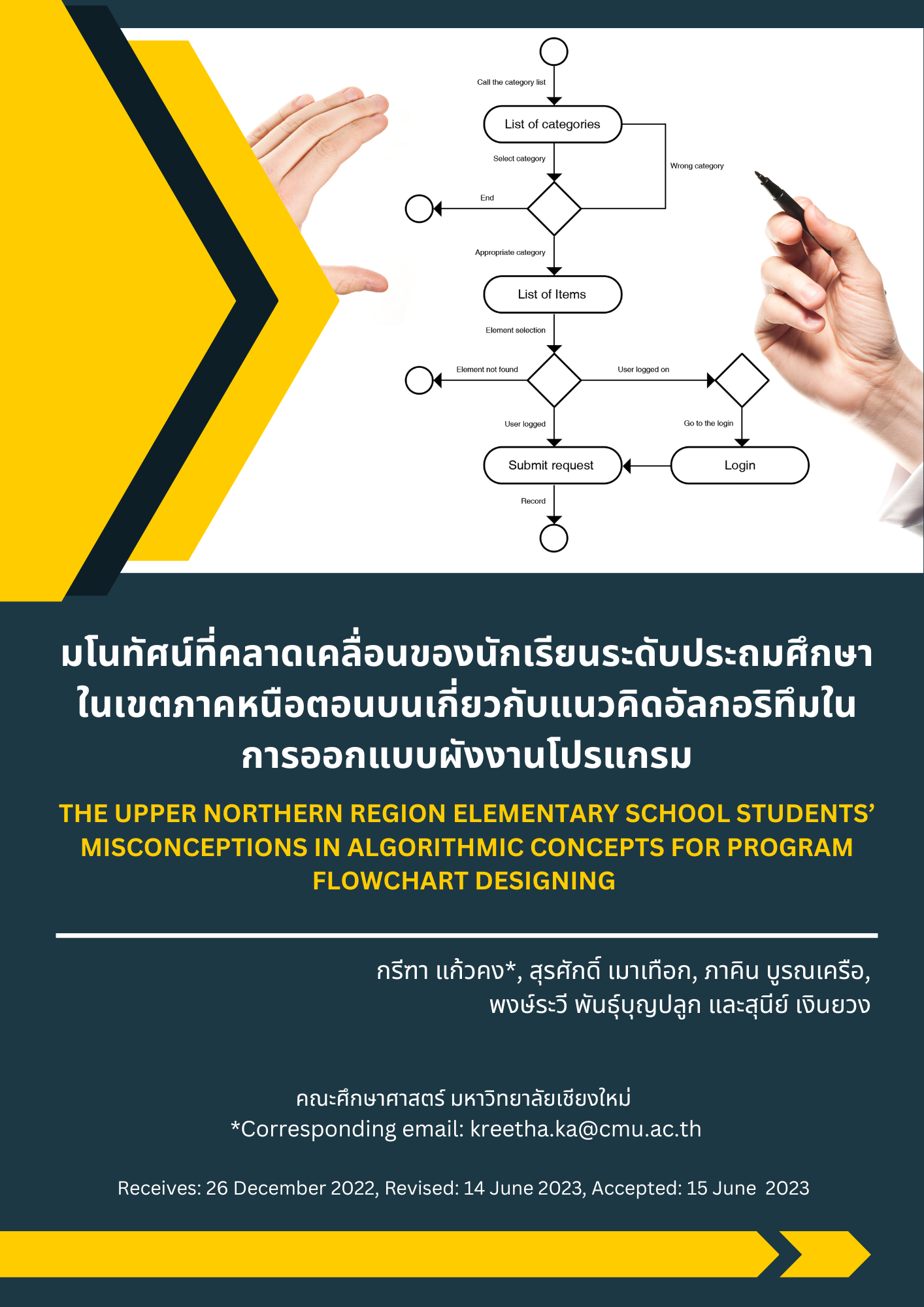มโนทัศน์ที่คลาดเคลื่อนของนักเรียนระดับประถมศึกษาในเขตภาคเหนือตอนบนเกี่ยวกับแนวคิดอัลกอริทึมในการออกแบบผังงานโปรแกรม
คำสำคัญ:
มโนทัศน์ที่คลาดเคลื่อน, แนวคิดอัลกอริทึม, ผังงานโปรแกรมบทคัดย่อ
บทความวิจัยนี้เป็นงานวิจัยเชิงคุณภาพมีวัตถุประสงค์เพื่อศึกษามโนทัศน์ที่คลาดเคลื่อนของนักเรียนระดับประถมศึกษาเกี่ยวกับแนวคิดอัลกอริทึมในการออกแบบ ผังงานโปรแกรม (program flowchart) ของนักเรียนระดับประถมศึกษาเพื่อใช้ในการแก้ปัญหาในชีวิตประจำวันผ่านการเขียนโปรแกรมร่วมกับการใช้บอร์ดไมโครคอนโทรลเลอร์ Kidbright กลุ่มเป้าหมายคือนักเรียนระดับประถมศึกษาจำนวน 76 คน จาก 3 โรงเรียน ในเขตภาคเหนือตอนบน ที่เข้าร่วมโครงการยกระดับทักษะ โค้ดดิ้งสู่การประยุกต์ใช้ในท้องถิ่น สำหรับนักเรียนในโรงเรียนระดับการศึกษาขั้นพื้นฐานในพื้นที่จังหวัดภาคเหนือ การระบุมโนทัศน์ที่คลาดเคลื่อนเกี่ยวกับแนวคิดอัลกอริทึมพื้นฐานสามารถวิเคราะห์ได้จากผังงานโปรแกรม ที่นักเรียนสร้างขึ้นจำนวน 44 ผังงาน
ผลการวิจัยพบว่า นักเรียนมีมโนทัศน์ที่คลาดเคลื่อนเกี่ยวกับการเขียนผังงานโปรแกรมที่หลากหลายซึ่งสามารถแบ่งออกเป็นสองลักษณะคือ มโนทัศน์ที่คลาดเคลื่อนที่พิจารณาจากปัญหาและอุปสรรคเกี่ยวกับการแก้ปัญหาจากการนำผังงานโปรแกรมที่สร้างขึ้นมาประกอบเข้าด้วยกัน (plan-composition problems) และ มโนทัศน์ที่คลาดเคลื่อนที่พิจารณาจากปัญหาและอุปสรรคเกี่ยวกับโครงสร้างภาษาและไวยากรณ์ของการเขียนโปรแกรม(construct-based problems) นอกจากนี้ มโนทัศน์ที่คลาดเคลื่อนเกี่ยวกับการตั้งเงื่อนไข มโนทัศน์ที่คลาดเคลื่อนเกี่ยวกับการวนซ้ำ และ มโนทัศน์ที่คลาดเคลื่อนเกี่ยวกับอัลกอริทึมย่อย เป็นมโนทัศน์ที่คลาดเคลื่อนซึ่งปรากฏมากที่สุด กล่าวคือ ร้อยละ 84.00 ของ ผังงานโปรแกรมทั้งหมด
เอกสารอ้างอิง
An, S., & Lee, Y. (2015). Designing a Programming Course for Enhancing Pre-service Teachers’ Programming PCK. In EdMedia+ Innovate Learning (pp. 222-225). Association for the Advancement of Computing in Education (AACE).
Barendsen, E., Grgurina, N., & Tolboom, J. (2016). A new informatics curriculum for secondary education in the Netherlands. In International conference on informatics in schools: Situation, evolution, and perspectives (pp. 105-117). Springer, Cham.
Bohl, M. (1971). Flowcharting techniques. Science Research Associates, Chicago.
Chetty, J., & van der Westhuizen, D. (2015). Towards a pedagogical design for teaching novice programmers: design-based research as an empirical determinant for success. In Proceedings of the 15th Koli Calling Conference on Computing Education Research (pp. 5-12).
Clancy, M. (2005). Misconceptions and attitudes that interfere with learning to program. In Computer science education research (pp. 95-110). Taylor & Francis.
Choi, Y. (2017). Analysis and Application of Misconception Flowchart for Programming Control Structure Concept Learning. Journal of Korea Multimedia Society, 20(12), 2000-2008.
Elo, S., & Kyngäs, H. (2008). The qualitative content analysis process. Journal of advanced nursing, 62(1), 107-115.
Mangaroska, K., Sharma, K., Gašević, D., & Giannakos, M. (2022). Exploring students' cognitive and affective states during problem solving through multimodal data: Lessons learned from a programming activity. Journal of Computer Assisted Learning, 38(1), 40-59.
Putnam, R. T., Sleeman, D., Baxter, J. A., & Kuspa, L. K. (1986). A summary of misconceptions of high school Basic programmers. Journal of Educational Computing Research, 2(4), 459-472.
Rahimi, E., van den Berg, J. and Veen, W. (2013). Investigating teachers’ perceptions about the educational benefits of Web 2.0 personal learning environments. eLearning Papers, (35), 1-23.
Rahimi, E., Barendsen, E., & Henze, I. (2017). Identifying students’ misconceptions on basic algorithmic concepts through flowchart analysis. In International Conference on Informatics in Schools: Situation, Evolution, and Perspectives (pp. 155-168). Springer, Cham.
Robins, A., Rountree, J. and Rountree, N. (2003). Learning and teaching programming: A review and discussion. Computer science education, 13(2), 137-172.
Scanlan, D. A. (1989). Structured flowcharts outperform pseudocode: An experimental comparison. IEEE software, 6(5), 28-36.
Seppälä, O., Malmi, L. and Korhonen, A. (2006). Observations on student misconceptions—A case study of the Build–Heap Algorithm. Computer Science Education, 16(3), 241-255.
Shneiderman, B., Mayer, R., McKay, D. and Heller, P. (1977). Experimental investigations of the utility of detailed flowcharts in programming. Communications of the ACM, 20(6), 373-381.
Shulman, L. S. (1986). Those who understand: Knowledge growth in teaching. Educational researcher, 15(2), 4-14.
Sirkiä, T. and Sorva, J. (2012). Exploring programming misconceptions: an analysis of student mistakes in visual program simulation exercises. Proceedings of the 12th Koli Calling International Conference on Computing Education Research (pp. 19-28).
Sorva, J. (2007). Notional machines and introductory programming education. Transactions on Computing Education, 13(2), 1-31.
Spohrer, J. C. and Soloway, E. (1986). Novice mistakes: Are the folk wisdoms correct?. Communications of the ACM, 29(7), 624-632.
Wing, J. M. (2006). Computational thinking. Communications of the ACM, 49(3), 33-35.
Zhao, L., Liu, X., Wang, C., & Su, Y. S. (2022). Effect of different mind mapping approaches on primary school students’ computational thinking skills during visual programming learning. Computers & Education, 181, 104445.

ดาวน์โหลด
เผยแพร่แล้ว
รูปแบบการอ้างอิง
ฉบับ
ประเภทบทความ
สัญญาอนุญาต
ลิขสิทธิ์ (c) 2023 วารสารสหวิทยาการเพื่อการพัฒนา มหาวิทยาลัยราชภัฏอุตรดิตถ์

อนุญาตภายใต้เงื่อนไข Creative Commons Attribution-NonCommercial-NoDerivatives 4.0 International License.
แนวคิดและทัศนะในบทความเป็นความรับผิดชอบของผู้เขียนบทความ การนำบทความหรือส่วนหนึ่งของบทความไปตีพิมพ์เผยแพร่ ให้อ้างอิงแสดงที่มา และข้อมูลเกี่ยวกับผู้เขียนบทความ



